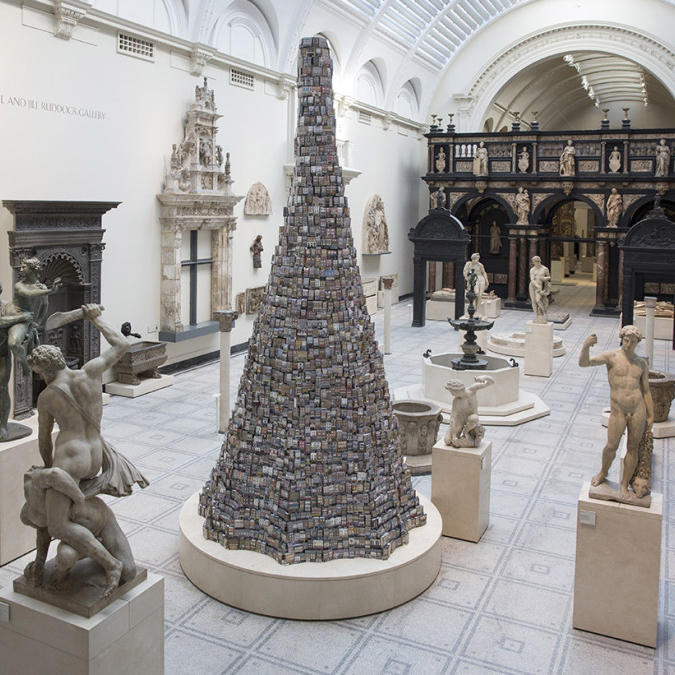British artist Barnaby Barford has cycled over 1,000 miles of London in the past two years photographing 3,000 shops across the sprawling city. Each image in his collection was meticulously edited and fired permanently onto bone china shop miniatures. His goal was to create a snapshot of London commerce in the form of a huge mountain of the stacked components displayed in the atrium of the Victoria & Albert Musem, an epicenter for contemporary ceramic art. Barford’s Tower of Babel stands 20 feet high (6.5m) and is on display at the V&A through November 1st.
Above Image: Barnaby Barford, Tower of Babel, Installation view inside The Victoria and Albert Museum’s Medieval and Renaissance Galleries. Image: Courtesy of the artist and the Victoria and Albert Museum
In May, I had the pleasure if meeting with Barford at his home is Northeast London. An avid cyclist, he insisted that we bike to his nearby studio and after a terrifying ride through narrow passes, sharp turns, and on the side of highways (not to mention the cars on the opposite side of the road) we arrived at his space in an industrial compound. Here, I got a peek at that Tower of Babel model, which Barford stared at pensively as if trying to convince himself that the 2-foot mess of tiny blocks could actually be the calculated 20-foot tower revealed earlier this week. It was the perfect time to talk to Barford about the project, far enough along that he could finally conceive it as reality, but distant enough that he had to strain himself to envision it in his minds-eye.
The V&A explains the concept of the Tower of Babel:
“Standing as a monument to the great British pastime of shopping, Barford’s apparently precarious Tower playfully likens our efforts to find fulfillment through retail with the biblical Tower of Babel’s attempt to reach heaven. Explicitly blurring the boundaries of art and commerce, each shop in the Tower will be for sale during its exhibition. With more prestigious but less affordable properties higher in the Tower, Barford confronts us with the choices we ourselves make as consumers, through necessity or desire.”
The Tower of Babel is a celebration of the local community which Barford is so passionate about. The activity of going to the museum to see the piece even reinforces community, bringing people together and fostering a game of finding their neighborhood icons, reminiscing about the changes, and celebrating what it means to be a Londoner.
It is a snapshot of London today and it will soon be a relic if it isn’t already; London has changed a lot since the project began two years ago. A darker side of the piece highlights what might be slipping away as local stores are overtaken by franchise businesses and also a general shifting cultural sentiment.
Barford told Dezeen, “I think we’ve ceased to be citizens and we’re now just consumers. So I wanted to explore that within our city.”
The shops on the tower are arranged hierarchically by the economic status of their target consumer. The derelict shops and pound stores are at the bottom and as you make your way up the quality of the stores increase. To parallel the commerce theme and bottom-to-top hierarchy, each individual porcelain shop is for sale beginning at £95 for those at the bottom, going up to £6,000 at the top. Keep in mind they are all alike except for the unique images…
The Tower of Babel installation draws parallels with how community actually functions. Local shops, the accessible ones at the bottom, are community gathering places and hold a sense of familiarity, while the high-end shops, the ones out of reach and view, enforce exclusivity, superficiality, define class, and are a destination, not a something you “just happened to stop at on your way home.”

Visitors pose for pictures beside ‘The Tower of Babel’ by Barnaby Barford. Photo: Justin Tallis/Getty Images
“[The Tower of Babel is] forcing the viewer to confront where they fit into this hierarchy of consumption,” Barford told Dezeen.
And he didn’t exclude himself from the introspective effect of his work. The crowning shops on the tower include Christies, Sotheby’s, Gagosian Gallery, Hauser & Wirth, Marian Goodman Gallery, and White Cube, the world’s most prestigious art sellers. In getting to know Barford his passion for his community is clear, he biked over 1,000 miles to celebrate it, but his feet are in two disparate worlds. Using the tower, he points to art, his own profession, as the epitome of sterile community and decadent consumerism.
Justin Crowe is a Writer and Director of Operations at CFile.
Any thoughts about this massive undertaking of contemporary ceramic art? Share yours in the comment box below!
Barnaby Barford: The Tower of Babel from Victoria and Albert Museum on Vimeo.

Barnaby Barford, Tower of Babel – Shop Detail, Image: courtesy of the artist

Barnaby Barford, Tower of Babel (detail), Image: Courtesy of the artist and the Victoria and Albert Museum

Barnaby Barford, Tower of Babel, Image: Courtesy of the artist and the Victoria and Albert Museum

Barnaby Barford, Tower of Babel (detail), Image: Courtesy of the artist and the Victoria and Albert Museum

Barnaby Barford, Tower of Babel (detail), Image: Courtesy of the artist and the Victoria and Albert Museum

Barnaby Barford, Tower of Babel (detail), Image: Courtesy of the artist and the Victoria and Albert Museum

Barnaby Barford, Tower of Babel (detail), Image: Courtesy of the artist and the Victoria and Albert Museum. Click to see a larger image.

Barnaby Barford, Tower of Babel (detail), Image: Courtesy of the artist and the Victoria and Albert Museum

Barnaby Barford with shop images.

Barnaby Barford, Tower of Babel (detail), Image: Courtesy of the artist and the Victoria and Albert Museum


fab
This looks amazing